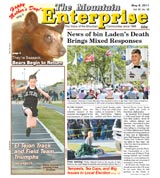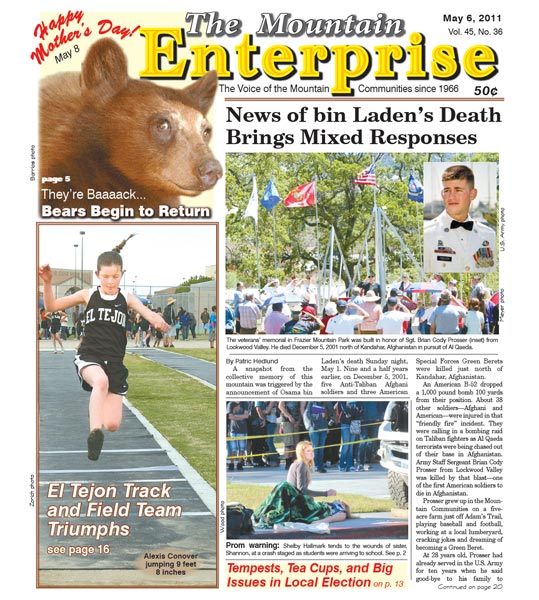Frazier Park (Thursday, May 5, 2011 at 3 p.m.)—The California High-Speed Rail Authority board has voted to allocate funds to take another look at routing the high speed rail "bullet train" through the Interstate 5 corridor known as the Grapevine, according to their press release dated Thursday, May 5. This would be an alternative to passing through the Antelope Valley with a station in Palmdale. Los Angeles County Supervisor Michael Antonovich is reported to be objecting strenuously to an alternate plan. The board said the alternate route could save $1 billion in building expenses.
We include the entire press release below so readers will be able to see the scope of the board’s discussion and the context in which this question is being considered. The board allocated a six figure sum to staff for a "conceptual review of the Grapevine alternative…to assist staff in determining whether the option is viable," the board’s release said.
There are early reports that Tejon Ranch, partners in the Tejon Mountain Village and Centennial developments along the Grapevine (proposals that could bring 4,500 and 23,000 new homes to the area, respectively), have vehemently objected to a Grapevine plan, including threatening litigation. We are seeking to confirm those reports and will report further in the next issue of The Mountain Enterprise newspaper.—Patric Hedlund
HIGH-SPEED RAIL AUTHORITY BOARD TAKES ACTIONS ON STATEWIDE PLANNING (press release)
SACRAMENTO – The California High-Speed Rail Authority Board of Directors met today to hear engineering and environmental progress reports from the Bay Area to the Los Angeles Basin. Refined alternatives and planning options were heard for five segments of the statewide high-speed rail line.
The major actions were:
Grapevine conceptual study approved
The Board approved beginning a conceptual study of an alternate alignment between Bakersfield and Los Angeles—an alignment that would generally follow Interstate 5, along the route known as the Grapevine – to determine if it may be considered as a feasible alternative along with the two Antelope Valley alignments being studied to connect Bakersfield to Los Angeles.
“We’re looking at as many alternatives as possible to make sure we construct the best system we can," said Roelof van Ark, CEO of the California High-Speed Rail Authority. “The Grapevine route could offer some advantages by saving time, distance and cost. A conceptual study gives us a chance to talk to the public and stakeholders to determine whether it will ultimately work."
Staff requested to reintroduce the study of the Grapevine alignment, which was conceptually studied in the statewide programmatic environmental review conducted in 2003-2005, because since that time a number of factors have changed in the corridor. In 2005, the Grapevine alignment was not selected based on preliminary information that revealed it to be technically less viable and potentially more costly than the Antelope Valley route.
“We’re looking at all factors and all means to get past the Tehachapi Mountains and into the Los Angeles Basin – and if that means we need to give the Grapevine another look, now is the time to do it,” said van Ark.
The conceptual review of the Grapevine alternative is expected to assist staff in determining whether the option is viable, or whether it contains fatal flaws. If it is viable, staff could return to the Board in four months to recommend its inclusion in the environmental impact report alongside the two existing alternatives that travel near the SR-14 through the Antelope Valley, with a proposed station in Palmdale.
Work on the other two alignment alternatives in the Antelope Valley will continue while this conceptual study occurs.
Ground level tracks and new station option approved for Central Valley segments
The Board approved staff recommendations to bring tracks and station approaches to at-grade, ground level, within the cities of Merced, Fresno and Bakersfield rather than portions of previously studied aerial structures.
At-grade high-speed rail tracks include added safety benefit of creating grade separations between rail and automobiles and also reduction of environmental, sound and visual impacts.
Fresno
The amount of proposed aerial track has been reduced from 14 miles down to approximately two miles. There are now two proposed station alternatives in downtown Fresno, both of which are at-grade with pedestrian over-crossings to provide increased access and transit oriented development. The station alternatives are located near Mariposa Street, which is the newest location to be studied, and Kern Street.
Staff will now study an underpass solution within the City between West Olive Street and Stanislaus Street due to technical complexity required to cross State Route 180, an irrigation canal and existing freight rail lines.
Merced
The downtown Merced high-speed rail station was previously studied as an aerial structure north of Martin Luther King, Jr. Way but staff will now be considering only an at-grade station located between Martin Luther King, Jr. Way to the northwest and G Street to the southeast.
Corcoran
A new alternative has been introduced that allows the study of an at-grade alignment through the City of Corcoran. This alignment alternative will be located west of the existing BNSF freight lines.
Kern County
The Board approved staff recommendations to alter the track design being studied from aerial to at-grade north and south of Shafter.
South of Shafter, staff will now be analyzing at-grade tracks to the west of the existing BNSF rail lines to avoid impacts and a new heavy maintenance facility proposal that mirrors the existing proposal in Shafter.
The bypass around Wasco and Shafter will be moved to the east to avoid impacts to a historic resource and a petroleum facility.
The approach into Bakersfield beginning at Hageman Road to Palm Avenue will no longer be studied as an aerial structure rather at-grade tracks in order to reduce environmental, sound and visual impacts.
Bay Area “phased approach” decision delayed
The Board delayed action on a possible “phased approach” and continued the discussion to its June meeting.
"It is imperative that we use taxpayer funding and our limited staff resources responsibly,” said Curt Pringle, Chairman of the Board. “It is not prudent to continue spending money for studies in a corridor where there is a lack of clarity on what the path forward may be. Recent proposals by some elected officials from the Peninsula to modify planning in the corridor will require further analysis and discussions with stakeholders.”
Staff had presented the Board with a request to modify current planning to include a “phased approach” – a gradual introduction of high-speed train service over time to allow for the eventual goal of constructing high-speed tracks for dedicated service into San Francisco, as envisioned by the language of Proposition 1A. The lack of Board action on the request means engineers will not move forward studying the phased implementation approach.
The draft environmental impact report for the San Francisco to San Jose segment is currently scheduled for mid-2012, with a final Board decision on route and track design anticipated for early 2013.
Additional track design options included for Gilroy, Morgan Hill
The Board approved the staff report to include additional track design options for analysis from Morgan Hill south to Merced.
Design options that will be studied include aerial, at-grade, open trench, and partially covered trench options in downtown Gilroy, aerial and at-grade options approaching the east of Gilroy option and at-grade and aerial options through Morgan Hill along the Caltrain corridor.
The alignment through the western portion of the Pacheco Pass was slightly adjusted to compensate for potential landslide areas and a new option for the connection near the area known as the “Wye” near Chowchilla was introduced for study.
California’s High-Speed Train System
The California High-Speed Rail Authority is developing an 800-mile high-speed train system that will operate at speeds of up to 220 miles per hour, connecting the state’s major urban centers, including the Bay Area, Fresno, Los Angeles and San Diego. The first phase of the project, San Francisco to Los Angeles and Anaheim, is projected to cost $43 billion. Initial infrastructure construction will begin in the Central Valley, the backbone of the system, in 2012. The project is being funded through a voter-approved state bond, federal funding awards and public-private partnerships.
This is part of the May 06, 2011 online edition of The Mountain Enterprise.
Have an opinion on this matter? We'd like to hear from you.


